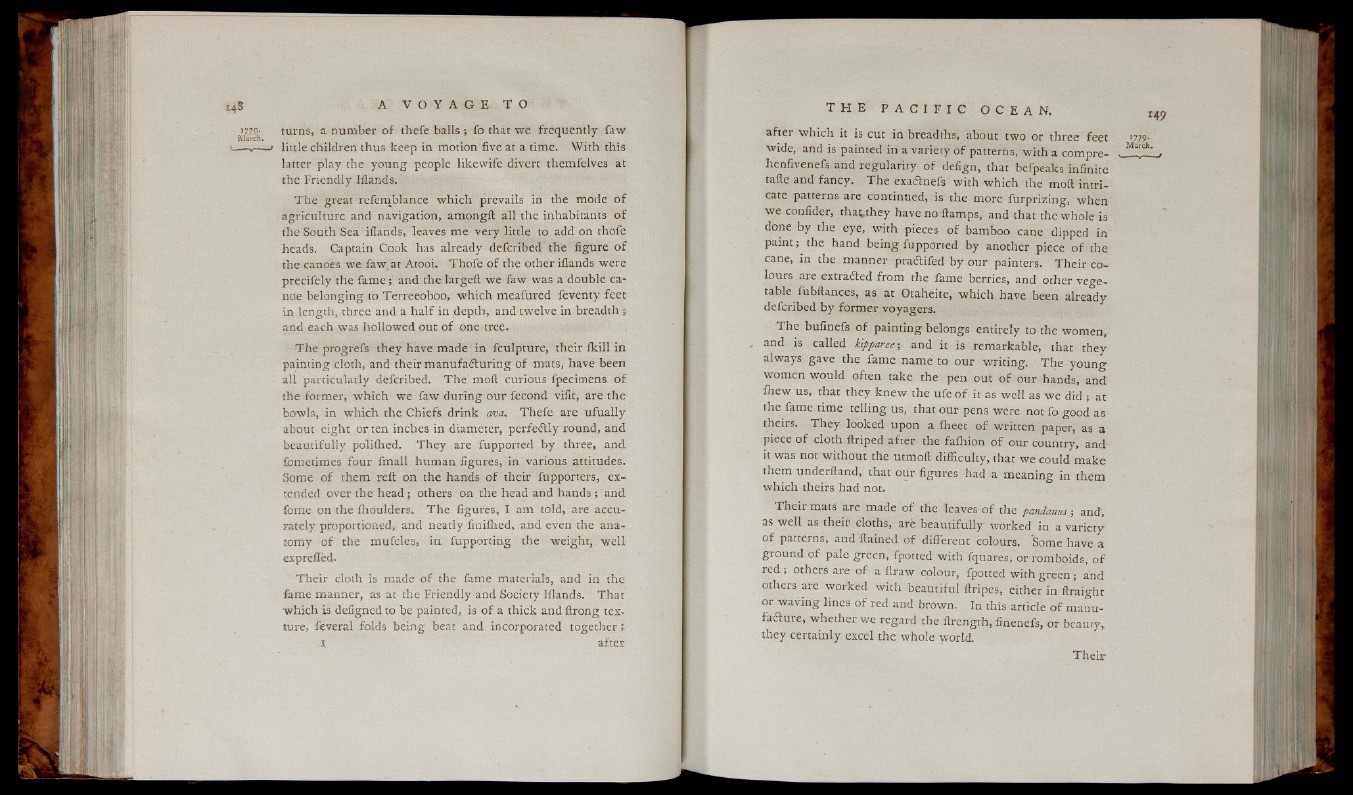
>779- turns, a number o f thefe balls ; fo that we frequently faw
M a rch . . .
— —j little children thus keep in motion five at a time. With this
latter play the young people likewife divert themfelves at
the Friendly Iflands.
The great refernblance which prevails in the mode of
agriculture and navigation, amongft all the inhabitants of
the South Sea iflands, leaves me very little to add on thofe
heads. Captain Cook has already defcribed the figure o f
the canoes we faw. at Atooi. Thofe o f the other iflands were
precifely the f ame a n d the largeft we faw was a double canoe
belonging to Terreeoboo, which meafured feventy feet
in length, three and a half in depth, and twelve in breadth ;
and each was hollowed out of one tree.
The progrefs they have made in fculpture, their fkill in
painting cloth, and their m anufadluring o f mats, have been
all particularly defcribed. The moll curious fpecimens of
the former, which we faw during our fecond vifit, are the
bowls, in which the Chiefs drink ova. Thefe are ufually
about eight or ten inches in diameter, perfectly round, and
beautifully polifhed. They are fupported by three, and
fometimes four fmall human figures, in various attitudes.
Some o f them reft on the hands o f their fupporters, extended
over the head ; others on the head and hands ; and
feme on the ihoulders. The figures, I am told, are accurately
proportioned, and neatly finilhcd, and even the anatomy
o f the mufcles, in fupporting the weight, well
expreffed.
Their cloth is made o f the fame materials, and in the
fame manner, as at the Friendly and Society Iflands. That
which is deligned to be painted, is o f a thick and ftrong texture,
feveral folds being beat and incorporated together
i. after
after which it is cut in breadths, about two or three feet *779*
wide, and is painted in a variety o f patterns, with a compre- ■
henfivenefs and regularity o f defign, that befpeaks infinite
tafte and fancy. The exatftnefs with which the mod intri-
cate patterns are continued, is the more iurprizing, when
we confider, tha^they have no ftamps, and that the whole is
done by the eye, with pieces o f bamboo cane dipped in
paint; the hand being fupported by another piece of the
cane, in the manner pradlifed by our painters. Their colours
are extradied from the fame berries, and other vegetable
fubftances, as at Otaheite, which have been already
defcribed by former voyagers.
The bufinefs o f painting belongs entirely to the women,
and is called kipparee-, and it is remarkable, that they
always gave the fame name to our writing. The young
women would often take the pen out o f our hands, and
ihew us, that they knew the ufe o f it as well as we did ; at
the fame time telling us, that our pens were not fo good as
theirs. They looked upon a iheet o f written paper, as a
piece o f cloth ftriped after the faihion o f our country, and
it was not without the utmoft difficulty, that we could make
them underftand, that our figures had a meaning in them
which theirs had not.
Their mats are made o f the leaves o f the pandanus; and,
as well as theii cloths, are beautifully worked in a variety
o f patterns, and ftained o f different colours. Some have a
ground o f pale green, fpotted with fquares, or romboids, o f
led; others are o f a ftraw colour, fpotted with g re en ; and
others are worked with beautiful ftripes, either in ftraight
or waving lines o f red and brown. In this article o f manu-
faflure, whether we regard the ftrength, finenefs, or beauty,
they certainly excel the whole world.
Their